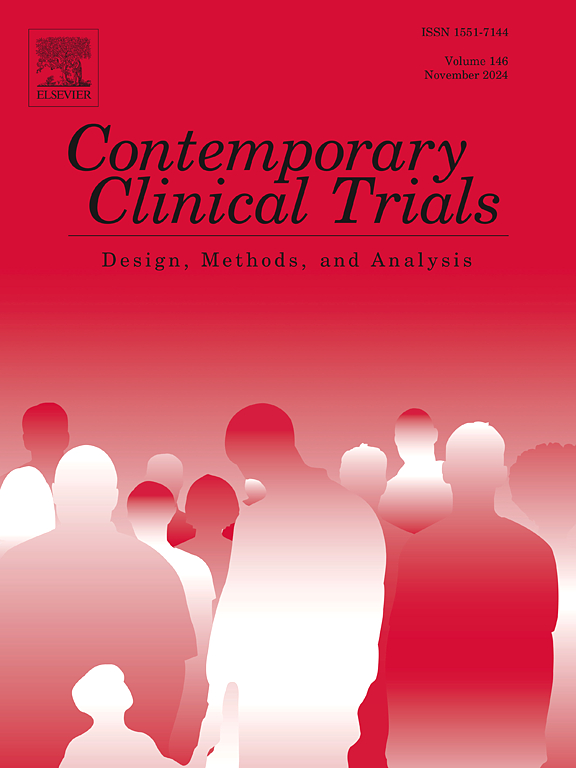评估生存推断的脆弱性指数,以评估估计治疗效果对生存终点的稳健性
IF 2
3区 医学
Q3 MEDICINE, RESEARCH & EXPERIMENTAL
引用次数: 0
摘要
III期随机临床试验(rct)旨在评估一种新疗法的益处。当在恶性肿瘤患者中进行时,大多数随机对照试验使用右删减终点,根据logrank检验的p值得出关于疗效的结论。最近,生存推断脆弱性指数(SIFI)被提出作为治疗效果稳健性的衡量标准。应用于真实的随机对照试验,报告的SIFI值非常低。我们假设这些值取决于试验的污染程度。方法:我们对参加随机对照试验的个体进行了模拟研究,在几种不同治疗效果、样本量和审查量的现实情况下产生生存时间。研究了具有非常特殊预后的个体对样本的污染。结果令人惊讶的是,在无处理效果的零值下,标准SIFI表现出非常低的值,对样本量的敏感性很差。然而,在零假设和备选假设下,p值和审查量都会影响值。相比之下,随机选择的患者,而不是在生存尾部选择的患者,对结果进行了广泛的修改,特别是在很大比例的病例中,不可能在null下找到值。当用结果很差或很好的个体污染样品时,结果接近标准。结论:SIFI不应该被用作生存试验稳健性的衡量标准,因为它涉及到一个非常特定的个体群体。至少,在其计算中应该随机选择患者。本文章由计算机程序翻译,如有差异,请以英文原文为准。
Evaluation of the survival-inferred fragility index to assess the robustness of the estimated treatment effect on survival endpoints
Background/aims
Phase III randomized clinical trials (RCTs) aim to evaluate the benefits of a new treatment. When conducted in patients with malignancies, most RCTs use a right censored endpoint, with conclusions regarding efficacy based on the value of the logrank test. Recently, the survival inferred fragility index (SIFI) has been proposed as a measure of the robustness of the treatment effect. Applied to real RCTs, the reported SIFI values were very low. We hypothesized that such values relied on the contamination of the trial. Methods: We performed a simulation study of individuals enrolled in an RCT, generating survival times under several realistic scenarios differing in treatment effects, sample sizes and amount of censoring. Contamination of the sample by individuals with a very specific prognosis was studied.
Results
Surprisingly, under the null of no treatment effect, the standard SIFI exhibited very low values, poorly sensitive to the sample size. However, under both the null and the alternative hypotheses, the value and the amount of censoring influenced the value. By contrast, randomly selected patients, rather than those selected at the survival tails, widely modified the results, notably with an impossibility of finding value under the null in a large proportion of cases. When contaminating the sample with individuals with very poor or good outcomes, results were close to those of the standard.
Conclusions
The SIFI should not be used as a measure of robustness of survival trials, as it relates to a very specific group of individuals. At least, a random selection of patients should be used in its calculation.
求助全文
通过发布文献求助,成功后即可免费获取论文全文。
去求助
来源期刊
CiteScore
3.70
自引率
4.50%
发文量
281
审稿时长
44 days
期刊介绍:
Contemporary Clinical Trials is an international peer reviewed journal that publishes manuscripts pertaining to all aspects of clinical trials, including, but not limited to, design, conduct, analysis, regulation and ethics. Manuscripts submitted should appeal to a readership drawn from disciplines including medicine, biostatistics, epidemiology, computer science, management science, behavioural science, pharmaceutical science, and bioethics. Full-length papers and short communications not exceeding 1,500 words, as well as systemic reviews of clinical trials and methodologies will be published. Perspectives/commentaries on current issues and the impact of clinical trials on the practice of medicine and health policy are also welcome.

 求助内容:
求助内容: 应助结果提醒方式:
应助结果提醒方式:


